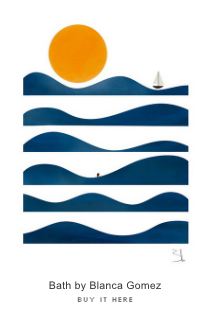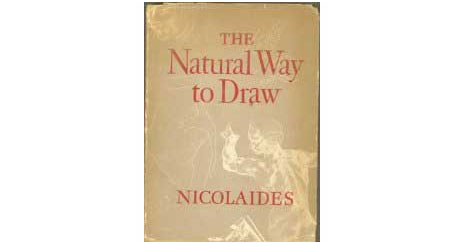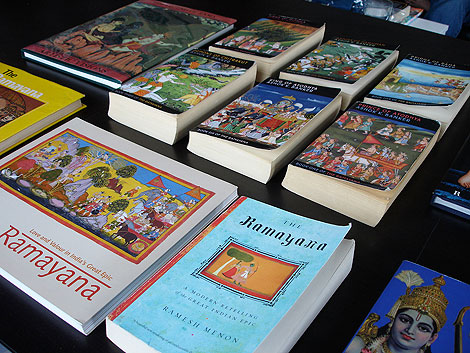Sanjay Patel Interview
Chronicle Books has just released Ramayana: Divine Loophole the latest book from Pixar animator and illustrator Sanjay Patel. As one of the core legends of Hindu mythology, Ramayana recounts a tale of Rama, a god-turned-prince, and his quest to rescue his wife Sita after she was kidnapped by a demon king. Sanjay is able to breath new life into this 2500-year-old epic tale with over 150 pages of lush, detailed illustrations.
In this interview, he gives us a glimpse into the making of the book and some of the challenges he faced along the way.
Lets start off with a little bit about your background. Where are you from originally?
I was born in the UK. and lived there till I was five. My parents then immigrated to Southern California, and began running and living in a motel off of route 66. So next time your in San Bernardino be sure to drop in on my folks at the Lido Motel. Yep thats really my parents motel and their vintage sign. They’ve been living and running the motel for thirty fucking years now!
When and how did you become interested in illustration?
As far a I can remember I was drawing. In elementary school my third grade teacher gave me a wonderful collection of hard bound vintage Superman comics. She wrote an inscription inside the book about what a wonderful artist I was and how I apparently had so much talent. She must of had me mixed up with someone else. Because the first thing I did with that book was draw all over the pages adding poop and pee coming out of all the great Superman panels. Eventually I began respecting my comics a lot more. I was really obsessed with a marvel artist named Michael Golden and his series called The NAM. From there I started watching a ton of Robotek and Looney tunes. But it was only until my high school art teacher gave me the famous Nicolaides “The Natural Way To Draw” book, did I finally get what drawing and illustration was all about. I dropped my comics and fell in love with Michelangelo, the Renaissance, and Norman Rockwell. The desire to communicate through a visual language has stayed with me ever since.
What led you to create a book on the Ramayana?
There were a lot of different impulses that led to the decision to tackle the Ramayana. In many way The Little Book of Hindu Deities was a success and at the same time really didn’t capture the full scope of my talent. As I began to read the Ramayana it became very clear that the mythology was loaded with a visually rich world. It was also very clear that no one has tried interpreting the epic story in pictures and illustration with a modern graphic flair. Or at least in a visual language that was in line with my aesthetics and love of mid-century animation.
How much time did you put into researching for the project?
I’m almost embarrassed to say this but I spent close to four years on the project. It took me the better part of a year to read different translations of the story and write my own summarized version. After selling both my manuscript and a full black and white dummy I took a year sabbatical from PIXAR to work on the ridiculously detailed vector illustrations full time. After working day and night for over a year and not leaving my apartment for days at a time I eventually ended up burning out. Luckily I discovered yoga and therapy and was able to finish the project.
How long did it take you to create the illustrations for the book?
Once a pencil sketch was done which took about two days I could jump into Adobe Illustrator and start building vector shapes, which took another three days depending on how complicated the illustration was. If I was lucky I would get things right, but in almost every case I re did things dozens of times.
What were some of the obstacles/ challenges that you faced along the way?
The biggest obstacle was of course the scope of the project, The Ramayana has dozens of character and locations, mega war scenes and complicated crowd illustrations. But somehow I was able to get things running fairly quickly that is until till I decided to redo everything top to bottom a few times. I kept fighting to work in a design style that was cute and silly, when the Ramayana is anything but that. As a reaction of too much cute I ended up turning the illustration into something much more grown up and stiff. Eventually the design pendulum settled somewhere in between cute and boring. Somewhere that I hope captures the action and drama in a fun modern style that honors this great mythology.
During the day you work at Pixar, how did you find time to work on this massive project?
That’s a long story, but what I can say is this. Growing up in a motel in a grimy part of San Bernardino I had very few friend’s let along neighbors. I spent most of my time drawing alone. In many way once I come home from work I want nothing more than to return to that same comfort of pencil and paper and solitude. Not much has changed in that way.
What artists/ books served as inspiration for your illustrations?
My office at Pixar is covered in Charley Harper pages. I actually bought two copies of the massive monograph that Ammo Books put out. I took one of the books and had it professionally cut and started using all the pages as wall paper for my office. So of course there is a ton of Harper in my everyday life and in my Ramayana. Like many other Cal Arts students I love mid century illustration. My favorites are Saul Steinberg, Provensons, & Sasek. Of course there are tons more artist that I love like Peter Arno, Tezuka, Steig, Boutavant, Lindberg, Wyeth,… And of course the great master Mr. Bill Watterson and his Calvin & Hobbes.
In what ways did the initial concepts differ from the finished book?
I wanted the book to be cute and silly like a Richard Scary version of the Ramayana. Instead I think I ended up with a weird Charley Harper, animation hybrid. Hopefully the combination works.
—————————-
SKETCHES / EXPLORATION
In this section Sanjay breaks down his explorations for the cover of the book.
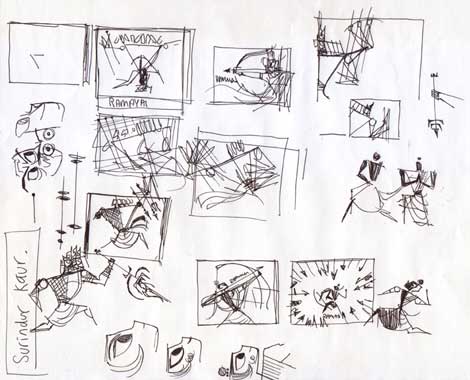
1. Early doodles of the characters and the cover.
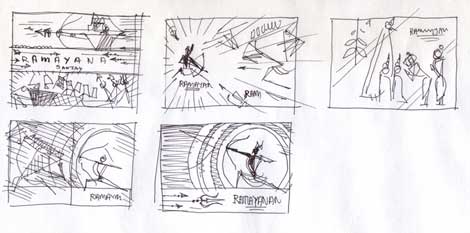
2. Thumbnail cover studies with type.
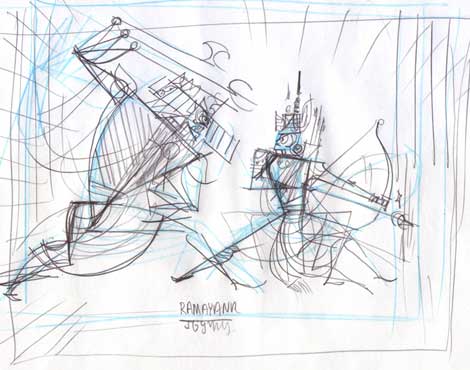
3. Decided on a direction and begin to play around with the character posing and graphic shapes.
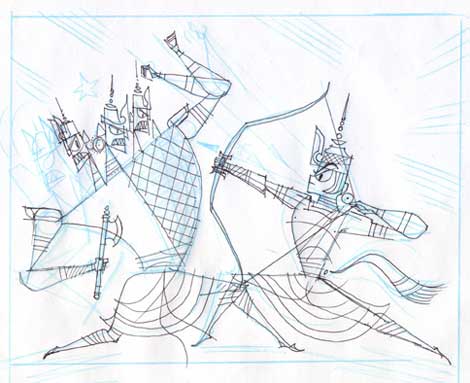
4. Refining the sketch to exact lines and patterns. While still pushing the posing and action
COLOR STUDIES TO COMPLETION
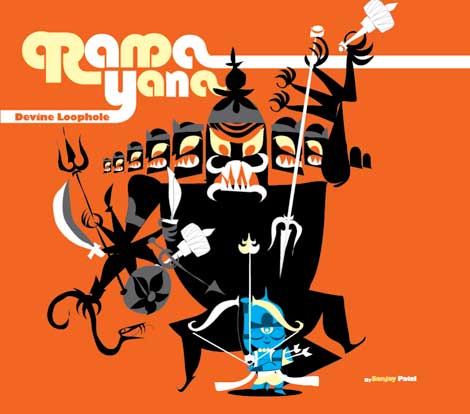
1. First color sketch, and initial type treatment
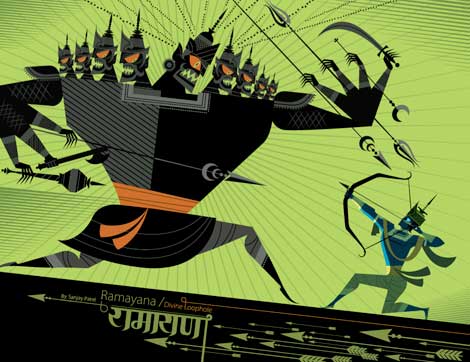
2. I changed the composition for better silhouette value and redesigned both characters.
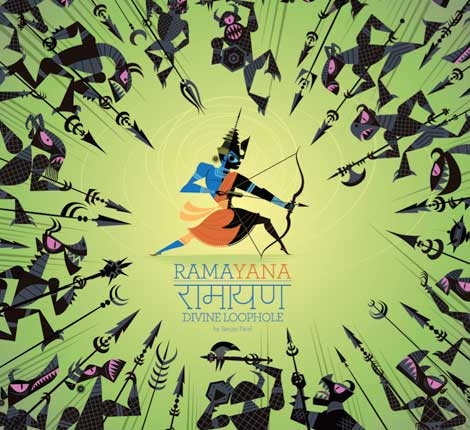
3. Tried a radial composition as well as a new Hindi type treatment.
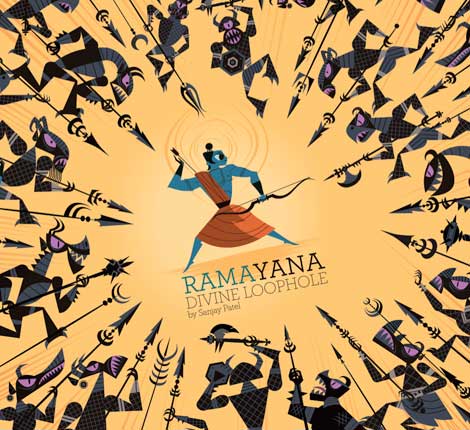
4. Tried a brighter palette and a new pose for the hero.

5. Switched to a limited palette and pushed the posing and scale of the figures.
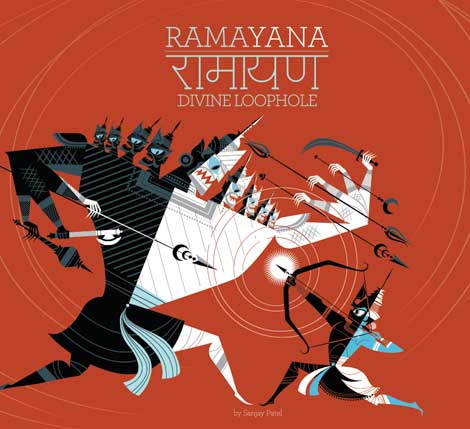
6. The title was getting lost in the artwork and was given a bolder and more formal treatment
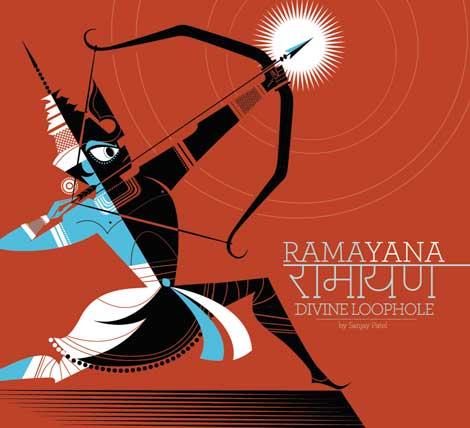
7. Decide to crop in on just the hero and balance the artwork against the type.
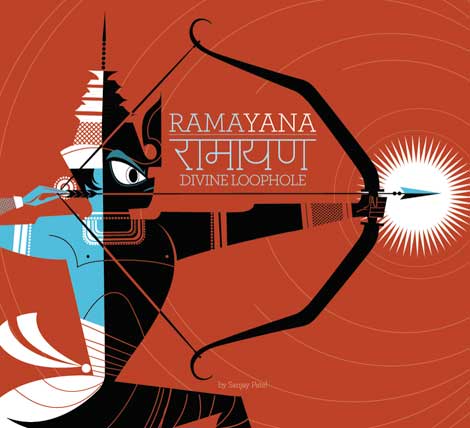
8. Used a more formal composition and played off the geometry of the graphic shapes.
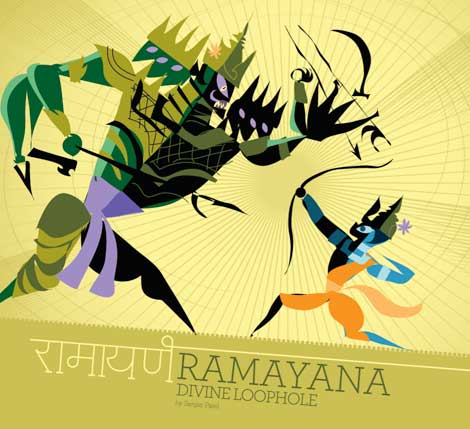
9. Tried a more colorful direction in a lose color sketch.
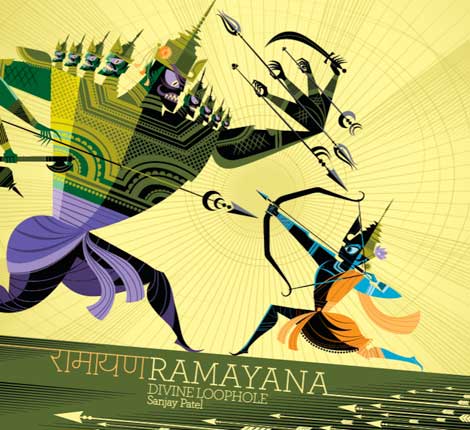
10. Finally found a composition and palette that the publisher and art director loved. This is the finished jacket artwork.

11. Managed to keep the punchy two color artwork for the casewrap of the book. Its a nice bonus for those who take a peak underneath the dust jacket.
———————-
Many thanks to Sanjay for taking time out of his day to share with grain edit readers.
You can purchase a copy of Ramayana: Divine Loophole at Amazon. Also available is a limited edition silkscreen print signed and numbered by Sanjay himself.
For more info on Sanjay, visit Ghee Happy, his online home.
———————-
Enjoy reading this interview? Please leave a note in the comments and consider signing up for our tasty free grain edit RSS feed.
Also worth checking: The Making of the Pixar WALL-E Picture Book – Lots of Bots.
———————-
TagsBooks, Illustration, Interviews



















